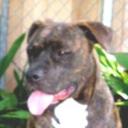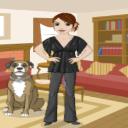Yahoo Answers is shutting down on May 4th, 2021 (Eastern Time) and beginning April 20th, 2021 (Eastern Time) the Yahoo Answers website will be in read-only mode. There will be no changes to other Yahoo properties or services, or your Yahoo account. You can find more information about the Yahoo Answers shutdown and how to download your data on this help page.
Trending News
House Training a puppy: Technique?
We have a puppy. The dog will get to be 10-12 pounds...so it's a small one. We had a Golden Retriever many years ago. The Golden used to "ease into it." before he "went." You had plenty of notice.
This little guy. "DOOT" and its done. 6 nano seconds. We're doing OKAY with the poops (forgive the graphic) but the pee...squat, "deet", and done..20 drops. Lightening fast! By the time you yell "HEY!' He's done...Been done...and wondering why you yelled.
We don't want to keep him in cage all day, we're also told that scolding him doesn't work, because he already forgot what he did. The vet tells us that rubbing his nose in it doesn't work.
Any tips?
8 Answers
- wishnuwelltooLv 71 decade agoFavorite Answer
Here are some tips, use what helps.
I use a crate* to potty train with, but only for potty training and then I break it down and store it. I put blankets and a small food and water dish in the crate. Dogs don't potty where they eat and sleep. When they are first little, I only expect them to hold their potty for 4 hours, and then 6 hours, then 8 hours and so on. So when they are first little, I set a timer or alarm clock to wake myself up at night to take them *out. I only allow my puppy in the bedroom* or the living room, only one room at a time. They have to graduate to more space. If I allow them to have full run of the house, it will overwhelm them. I take them out the same door each time. I tie a dinner bell to the door handle. Do not use a jingle bell as they could get their toe caught in it. So when they are little, I ring the bell for them, and then open the door to go *outside to potty. When they get bigger, I take their paw and whack the bell and open the door to go potty. Eventually getting to the place where the puppy will ring the bell and let me know when they need to go potty. Dogs want to please you, so it is your job to let them know what behaviors please you and what doesn't. So when my puppy goes potty, I give her a treat*, and clap, and make a fuss and praise her. So she learns that going potty outside makes me happy. If she has an accident, make a disgust sound like “tsst” and take her out right away. I never yell* or spank* my puppies. Take them out when they first wake up, after they eat or drink, before nap, finish romping, when their activities change, or when they are sniffing around. Some puppies go pee right away, but may not go poop until 10 minutes later, so wait for the poop. I have a little play time here, because sometimes I think they are done, and they are not. Puppies train at their own pace. While I may have a puppy that hasn't had an accident in several weeks, I don't let my guard down. I don't expect my puppies to be "fully potty trained" until one-year-old. If they have a setback, shake it off, and start over. I only have my puppies in the crate when I am not watching them. When I am sleeping, cooking, ironing, doing chores, basically when I am not watching her. All other times, she is out of the crate practicing being a "big girl." This is the time I train her how to behave in the house. So we are practicing "no barking", 'no biting", "no jumping", and "don't eat the furniture." I also have to practice "playing inside" so she doesn't knock over things. You must keep the puppy in sight when they are little because they don’t know the difference between newspaper and carpet, and you don’t want them sneaking off and getting into trouble. Some puppies can sleep through the night around 3-months-old, but their bladder is grown around 6-months-old.
REVISIONS:
*I use a CRATE to train with. It is the method I prefer, compared to other methods I have tried. I noticed that if they are in the crate, while I am doing chores, they are o.k., because the crate allows them to see me and be re-assured. The crate can also be a comfort when stored in the basement for dogs who live in areas where thunderstorms and tornados are an issue. . However, use the method that works best for you.....a laundry basket, a cardboard box, a woof-woof house, x-pen, child gates, whatever works for you.
*OUTSIDE, pee pad, litter box, whichever method you are using. When the puppy is first little, keep the pee pad, litter box near the food and water dish, so the puppy can eat and drink, and then go potty. You can move it away as they get older. The pee pad has a scent that smells and initiates potty. Sometimes a pee pad makes a sound that scares some puppies, so you might want to use a litter box if that happens. The pee pad allows a puppy to walk around, but a litter box keeps the puppy in one place.
*BEDROOMS, I use the bedroom and living room for training, because it works for me. Choose rooms that work for you, but watch for rooms that are damp, or drafty. While my puppies sleep in the bedroom during training, once they are trained, I let them sleep where they want to. They don't have to sleep in the bedroom forever.
*TREATS. While I use treats for training, you don't have to. I like Charlee Bears for training (a little cracker for a little mouth,) I use them for training, but once they are trained, I cut back on them.
*SOME PUPPIES will go potty in the same spot each time. Some puppies have to be told to go potty. A command like "go out" for pee, or "go finish" for poop, might work for you, keep saying “go finish” until the puppy poops. This is a good thing to train if you travel with your dogs. By using commands, the puppy won't get confused when you are visiting someone, on vacation with you, or when you get to a new home. The command will tell them what you want them to do in an unfamiliar place. You might also want to use a leash
- SocionLv 61 decade ago
Breeders of toy dogs often make the mistake of raising the puppies in a large whelping box since the dogs are small and the waste is easily controlled. This can lead to housetraining difficulties. Larger-breed puppies are usually raised in a large room or outside, and the puppies learn at a young age that there is a place to eat and sleep, and a separate place to eliminate.
Are you carrying him outside, or making him walk outside to potty? He should be leashed and walked just like a big dog is because if you pick him up, he'll learn to wait around to be picked up. Besides, walking usually stimulates the dog to eliminate. Set a timer and take him outside every 1-2 hours. If you have to, set a clock and get up during the night as well. If you keep him in a crate at night or when you have to leave the house for a few hours, the crate should only be big enough for him to stand up, turn around, and lie down in.
It is easier to avoid mistakes than to discipline them, so you should supervise him well. Use baby gates to confine him to one or two rooms for the time being. If you notice any signs he is looking for a place to "go", lead him outside. You can keep a short lead attached to the collar for this purpose. If you actually do catch him eliminating in the house scoop him up immediately which will stop the flow, say "no!" and take him outside to finish his business.
- *****Lv 71 decade ago
Here's the potty training approach that worked for my small dog (after lots of trial and error): First, you need to clean anywhere in your home the dog has an accident with an enzyme cleaner, even if you can't smell it, your dog can, and will go back to the same spot over and over because of it. If you don't know where your dog has gone (like if you have a darker colored carpet), a blacklight will find any spots for you to treat.
Crate training seems to work the best, at least for me, and no puppy pads in the house. They seem to confuse dogs. How come it's ok some of the time to pee in the house, but not all of the time? Plus they look sort of like rugs, so many dogs will begin to pee on your kitchen and bath rugs as well.
Supervision is key. When you're not home he should be crated or otherwise confined. When you are home, he should be leashed and tied to you. An 'Umbilical' lead that goes around your waist works well, you can still go about your business at home and not have to worry about the dog sneaking off to 'go'. Take him out every half hour to hour at first. If the dog does start to go in the house, interrupt with a sharp noise (I clap my hands), pick it up and take it outside. Praise profusely when the dog finishes going outside.
I also trained mine to ring a bell by the door when he needed to go out (took me about 3 months before he really used it regularly). I put a desk bell by the front door, rang it with his paw and said "Let's go Potty", and then we went out for his potty break. If he didn't go, straight back inside, no time to play. If you let the dog play, it will start to think the bell means they get to go out and play in the yard. You want it to mean the dog needs to potty. If you ring it every time you take the dog out to potty, the dog will eventually make the connection and start to ring it himself when he needs out. The day the dog figures this out will be trying, as they often will spend all day ringing it repeatedly (I think it's the novelty factor). You have to take the dog out every time it rings it or the dog will stop using it, but don't let the dog wander and play, just give your potty command and if the dog doesn't get to going pretty quickly, take it back inside.
- OhIDoDoILv 51 decade ago
Lol... that image makes me laugh. I know the exact speedy-pee that you're talking about.
My only suggestion, since you understand that rubbing his nose in it or scolding him any time other than during the pee won't do a thing, (good things to know :) ) is spend more time hanging out with him outside in the area you want him to potty. Bring a book. I found it really useful to teach a "potty" word. Repeat the word over and over and over again until you're blue in the face... when he potty's, praise treats and play. It takes time but on days when it's freezing and snowy this is a huge help.
If you can't catch him in the act, you're going to have to put more emphasis on the catching him when he does a good thing side of it.
When he does the tiny pee in the house you can still dash his furry behind outside as fast as you can, in hopes he's not quite done. Hang out with him and wait for a "correct" potty outside, so you can praise. You're right though in that the scolding won't help you do anything but make him confused and scared of you.
- How do you think about the answers? You can sign in to vote the answer.
- 1 decade ago
I have owned three dogs however they had been adopted either when they were older and were easier to train or they became complete outside dogs. I did fin this website and more like it.
http://www.peteducation.com/article.cfm?cls=2&cat=...
http://www.wikihow.com/House-Train-a-Puppy
http://www.ehow.com/how_32_house-train-puppy.html
I hope that these will be helpful to you.
Source(s): Owned three dogs, never had an issue with them - Anonymous1 decade ago
If you can see you dog about to go for a wee then pick them up and put then out side it should work because it worked with my dog but i don't know if it will but it is worth a try.
- JMLv 71 decade ago
take your dog out more often, a puppy has a tiny bladder and needs to go out often. when he goes outside reward him with positive remarks and a healthy treat. he will get it!
- Anonymous1 decade ago
Use a shock collar and a baseball bat. That ought to do the trick.
Hope this helps.
Note: I am assuming by the ratings on my answer that dog owners do not possess a sense of humor?








